Abstract
In this paper, an adaptive backstepping control scheme is proposed to solve the the surge motion tracking control problem of an autonomous undersea vehicle (AUV) with system constraint. First, an initial rectification reference signal is constructed for the subsequent implementation of deferred output constraint and making the control input smaller and smoother in the early stage of system operation. Second, a barrier Lyapunov function is adopted for developing an output-constrained state feedback adaptive controller. Then, on the basis of coordinate transformation and estimating the derivative of surge displacement by a linear and nonlinear combined differentiator, we develop an output feedback adaptive backstepping control scheme for AUVs whose velocity signals are unmeasurable. We also carried out a comparative numerical simulation with traditional adaptive control to verify the feasibility of the proposed control strategy.
1. Introduction
An autonomous underwater vehicle (AUV) is an important piece of equipment in marine scientific research, resource development and marine military forces [1]. The precise motion control of AUVs is helpful to complete the tasks of reconnaissance, underwater measurement and target tracking, and it has received considerable attention from researchers and engineers. Since the 1990s, many advanced control technologies have been adopted for this issue, such as sliding mode control [2], adaptive control [3], neural network control [4], fuzzy-PID [5], predictive formation tracking control [6], etc.
The motions of an AUV have six degrees of freedom (DOFs) including surge, sway, heave, roll, pitch and yaw motions (see Figure 1). Among them, surge, sway and heave refer to the longitudinal, sideways and vertical displacements; yaw, roll and pitch describe the rotations around the vertical, longitudinal and transverse axes. The surge motion control of AUVs mainly includes velocity and position tracking control, which plays an important role in many tasks, such as automatic docking, position keeping, precise exploration, reconnaissance and data acquisition [7,8,9]. When an AUV is in motion, due to the complex operating environment, current fluctuation and other uncertainties and disturbances, it is difficult to obtain an accurate dynamic model. In [7], Marco et al. developed a method for identifying the decoupled surge motion dynamic parameters of a small AUV. In [10], Fossen proposed PI control and PID control methods to design the controller for the accurate position tracking of the underwater vehicle’s surge motion. In [11], Smallwood et al. developed an adaptive controller while ignoring the influence of current. In [12], Riedel design a sliding mode variable structure controller for AUV without strict stability analysis. In [13], Gao studied the surge trajectory tracking problem of AUVs under the influence of current and presented an adaptive backstepping sliding mode control scheme. In [9], Herlambang et al. proposed a sliding-PID method for surge motion control and roll motion control. In [14], Yu et al. proposed an improved adaptive backstepping control algorithm to decrease the too large initial control input. In [15], Li et al. studied the backstepping control to solve the surge position tracking control problem of AUVs with input limitation. These research results promote the development of AUV control technology.

Figure 1.
Six DOFs motions of AUVs.
The aforementioned control algorithms can work well while all system states can be accurately measurable. An AUV may be equipped with a compass module to measure its attitude, and angular velocities can be measured by an angular rate sensor. By using the typical positioning systems (including acoustic ultrashort baseline system, GPS, inertial navigation system, etc.), it is not difficult to obtain the positions of AUVs with very good accuracy. Usually, their translational velocities can be obtained by the Doppler velocity log (DVL). However, in some cases, due to economic and other practical limitations, AUVs may not be equipped with DVLs. Even when an AUV is equipped with a DVL, the DVL can only generate accurate velocity measurements provided that the distance to the seafloor is within a certain boundary, and the measured translational velocities by DVL may not be adequately accurate because of measurement noises [16]. During motion control design without velocity measurement or without accurate velocity measurement, it is necessary to obtain the accurate estimation of velocity for implementing an output feedback controller design. So far, there are mainly two technical means to estimate the velocity signal. A popular approach to velocity estimation entails the use of state observers [17]. Another approach is to use sliding mode differentiators [18]. For uncertain nonlinear systems, the state observer design is very complicated [19]. Even for the ideal situation, high-gain observers can be quite sensitive to measurement noises [18]. By contrast, sliding mode differentiators possess robustness to measurement noises [20]. In the context of motion control for AUVs, several output feedback control schemes have been proposed since the beginning of this century. In [21], the design and experimental results of a novel output feedback controller for slender-body underwater vehicles is proposed, with the velocity estimation achieved by using Luenberger observer. In [22,23], nonlinear observers are designed for velocity estimation. In [24], an adaptive output feedback controller based on dynamic recurrent fuzzy neural network observer is proposed. In [16], a finite-time-convergent observer is developed to solve the estimation problem of the translational velocities. Hitherto, in the context of AUV output feedback control, the results of using differentiators to estimate velocity signals are very few.
Real application systems usually operate under various constraints and restrictions arising from physical limitations or performance needs. Since this century, arising from the sustained research interest in the control field, a lot of results involving system constraints have been reported. These results promote the development of related technologies. Typical approaches of the class consist of model predictive control [25], reference governor [26] and barrier Lyapunov function [27]. In recent years, the design of state/output-constrained controllers based on barrier Lyapunov function has attracted great attention [28,29,30]. In the context of adaptive control design for AUVs, the number of relevant literature results is very limited [31]. The adaptive control design for AUVs with system constraints, as well as to meet the requirement of output feedback, is still a subject worthy of further study.
Motivated by the above discussion, this work investigates the output feedback adaptive control method for AUVs with deferred output constraint. The main contributions of this work can be summarized as follows:
- (i)
- The deferred output constraint in adaptive control design is implemented by constructing the auxiliary reference signal. Meanwhile, this construction is also beneficial to improve the smoothness of control input in the early stage of system operation.
- (ii)
- Both the state feedback control scheme and output feedback control scheme are developed for AUVs with deferred output constraints.
- (iii)
- By using the proposed control scheme, all the signals in closed loop are proved to be bounded, and better asymptotic tracking performance is achieved.
Remark 1.
PID algorithms are quite popular in industrial applications due to their simple algorithm and easy implementation. For the case that the derivative of output error is not measurable or cannot be accurately measured, PI control, as an alternative to PID control, is often adopted in the design of actual control system, which decreases the control accuracy. Moreover, the parameter tuning of PID control is not very easy. In PID control schemes, the demand of system constraint during system operation cannot be guaranteed.
The remainder of this paper is organized as follows. The problem formulation and the preliminaries are given in Section 2. The construction of the auxiliary reference signal is introduced in Section 3. State feedback control design and output feedback control design are discussed in Section 4 and Section 5, respectively. In Section 6, the numerical simulation comparison is carried out to verify the effectiveness of the proposed adaptive control scheme. Finally, Section 7 concludes this work.
2. Problem Formulation
The surge motion dynamics of AUVs can be described by the following formula as
where x represents the surge displacement state of AUV, u is the surge forward velocity of AUV relative to ocean current, c is the velocity of ocean current, m and are the mass of the AUV itself and the added mass, is the nonlinear surge drag coefficient, is the thrust force and is the unmodeled dynamics. In (1), m, , and are unknown constants, and holds. The reference trajectory is , which satisfies Assumption 1.
The control objective of this work is to develop a controller such that x can track the given reference trajectory , with being constrained during the operation of the AUV system.
Assumption 1.
is continuously differentiable, i.e., and are continuous with respect to time t.
Assumption 2.
c is time-varying but bounded, i.e., and , with being an unknown positive constant.
Lemma 1
([32]). For and ,
Lemma 2
([33]).
Consider a linear and nonlinear combined differentiator as follows:
where , , and are design parameters. For the continuous second-order differentiable signal , there exits and , which satisfy
Remark 2.
According to Assumption 2, the velocity of an ocean current is bounded, and the acceleration of an ocean current is also bounded, which is consistent with the actual situation.
For simplicity, in this paper, the arguments of functions are often omitted while no confusion arises.
3. Construction of Auxiliary Reference Signal
In output-constrained control based on barrier Lyapunov functions, the constraint parameter should be set large enough. For example, one designs a controller according to the barrier Lyapunov function as follows:
where is the design parameter for implementing system constraint. During controller design, must be set properly to meet . Since is different in each operation, it is a bit troublesome to set the appropriate value of during controller design. To overcome this problem, an auxiliary signal is formed as follows:
where
is a design parameter. According to the above construction, we can see that both , , and hold. The construction of such auxiliary signal is the basis of achieving deferred output constraint. For an AUV, when the absolute value of the initial error is large, if the controller is designed according to the conventional method, the control input in the initial stage of operation may be very large, even exceeding the maximum power that the AUV can provide. In the process of controller design, using instead of as the reference signal is helpful to solve this problem.
Remark 3.
The purpose of constructing an auxiliary signal lies in the following two points: (i) it brings convenience to deferred constraint control design; (ii) it can make the control input smaller and smoother in the early stage of system operation.
4. State Feedback Control Design
4.1. Backstepping Control Design
From (1), we have
Define and , where is a virtual controller to be designed. From the construction of , we can see that and for . From (7), we obtain
Then, we define a Lyapunov function as follows:
According to (8) and (9), we have
where . Through designing
with . Applying Lemma 1 and substituting (11) into (10), we can obtain
From (7), we obtain
Let , . Define .
A sigmoid neural network [34] is employed to approximate as follows:
where , with being an unknown constant,
, are the design parameters, and is an unknown bounded constant. Combining (15) with (14) yields
Based on (12) and (17), the following control law is designed as
where , , , and and are the estimations of and , respectively.
4.2. Stability Analysis
The system stability and constraint property of the AUV surge motion is established by the following theorem.
Theorem 1.
Proof.
Let us define a Lyapunov function as
where .
Applying (18), we have
By employing (19), we obtain
By using (20), we obtain
According to (24)–(26), we obtain
Similar to (25), from (21), we can derive
Combining (28) with (27), we obtain
in which , . Then, from (28), we obtain
Since is bounded, from (30), we can draw a conclusion that is bounded for . According to the definition of V, we can see that , and are bounded, and
Hence, by setting proper parameters , and , we can achieve the desired steady-state accuracy. On the other hand, since holds, from (30), we can see that holds for , which implies
According to the construction of , it follows from (32) that holds for . Furthermore, we can see that holds for . □
5. Output Feedback Control Design
In order to derive the adaptive control scheme based on output feedback, let us first consider the adaptive control design problem when u and c are known.
Define . We perform the following coordinate transformation for system (1) as
Let and , where .
Similar to the derivation in (10)–(12), by calculating the time derivative of , we have
where . On the basis of (33) and the definition of , we obtain
Define with . According to (35), we obtain
Similar to (15), the following equation holds as
where , , , are the design parameters and is an unknown bounded constant.
Combining (36) with (37) yields
where p denotes . Based on (38), the following control law is designed as
where , , , and and are the estimations of and , respectively.
Theorem 2.
Proof.
Let us define a Lyapunov function as
where .
Applying (34), (38) and (39), we have
Similar to (25), from (40) and (41), we can obtain and . From the above three inequalities, we can obtain
in which , . Up to this point, similar to the corresponding analysis in Section 4, we can conclude that holds, all signals in the closed AUV system are bounded and
□
It should be noted that the control algorithm (39)–(41) is applicable only to the case that both u and c are available. To be specific, when u is not measurable, and become uncertain variables, which causes the adaptive control algorithm (39)–(41) to be invalid. On the other hand, although the adaptive control algorithm (39)–(41) is invalid when u or c is unknown, it can still provide reference and help for controller design in the cases that only x is available.
To proceed with the controller design, we construct the following combined differentiator to estimate :
According to Lemma 2, by reasonably setting parameters , , and , can accurately track the signal , such that is an accurate estimation of .
On the basis of the above signal reconstruction, we can develop the output feedback barrier adaptive control law as follows:
where
, are design parameters of the neural network, and the other variables and parameters are similar to the corresponding ones in (39)–(41).
Remark 4.
Compared with the similar research results given in [13,14,15], the output feedback barrier adaptive control scheme (48)–(50) possesses the following characteristics:
- (1)
- The proposed control scheme may be used in the cases that velocity signals are unmeasurable. Therefore, the applicable scope is extended.
- (2)
- By incorporating the initial rectification technique into the barrier backstepping design, deferred output constraint adaptive control scheme is developed. So the robustness and safety of AUV systems have been improved.
6. Numerical Simulation
The REMUS UAV model is used to verify the performance of the controller, and the simulation parameters are selected according to [35] as follows: , , , . is set as . The reference trajectory is set as . The initial state is m and m/s.
The output feedback barrier adaptive control scheme (48)–(50) is adopted for simulation, with the parameters and gains in the proposed adaptive control scheme (48)–(50) set as follows: , , . The simulation results are shown in Figure 2, Figure 3, Figure 4 and Figure 5. Figure 2 shows the tracking curve of surge displacement, with the corresponding tracking error plotted in Figure 3. From Figure 2 and Figure 3, we can see that a favorable tracking performance was obtained. From Figure 4, we can see that is constrained within . Figure 5 shows the profile of the control input.
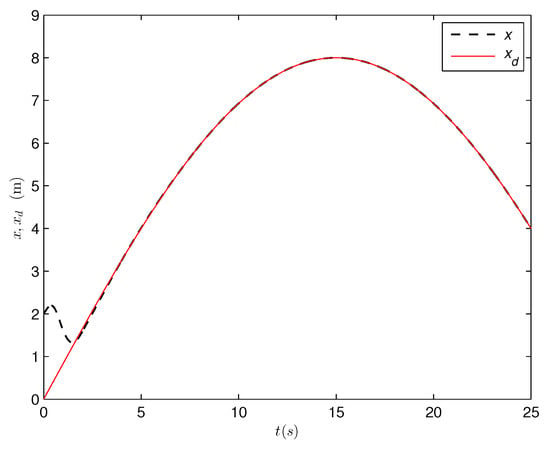
Figure 2.
Surge displacement(output feedback barrier adaptive control).
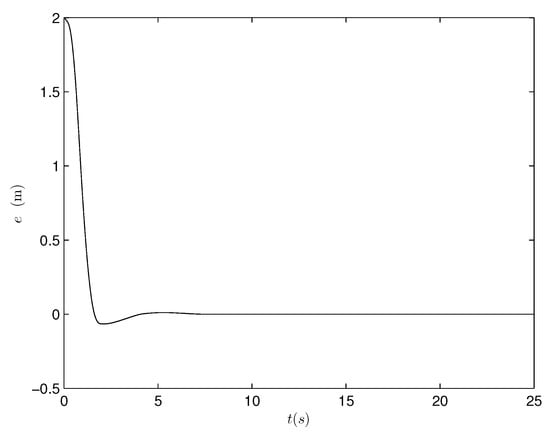
Figure 3.
Surge tracking error (output feedback barrier adaptive control).
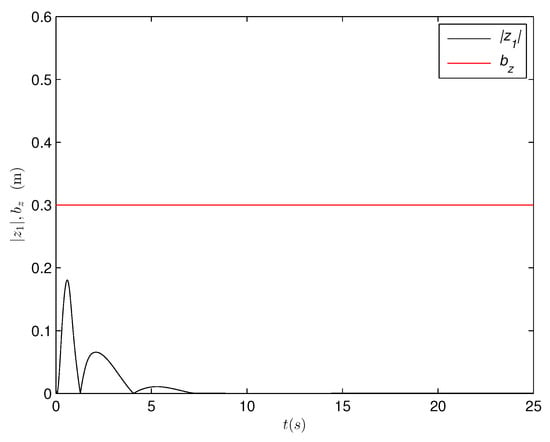
Figure 4.
Deferred output error constraint (output feedback barrier adaptive control).

Figure 5.
Control input (output feedback barrier adaptive control).
For comparison, a traditional adaptive control algorithm is adopted for simulation as follows:
where , , .
. The design parameters and gains are set follows: , , . Comparing Figure 2 and Figure 3 with Figure 6 and Figure 7, we can see that the tracking precision in the output feedback barrier adaptive control scheme is better than that in the traditional adaptive control scheme. Comparing Figure 4 with Figure 8, we can see that the deferred output error constraint is achieved in the output feedback barrier adaptive control scheme, whereas no system constraint is achieved in the traditional adaptive control scheme. Comparing Figure 5 with Figure 9, we can see that the control input of the output feedback barrier adaptive control is smoother and smaller than that of the traditional adaptive control scheme in the early stage of operation.
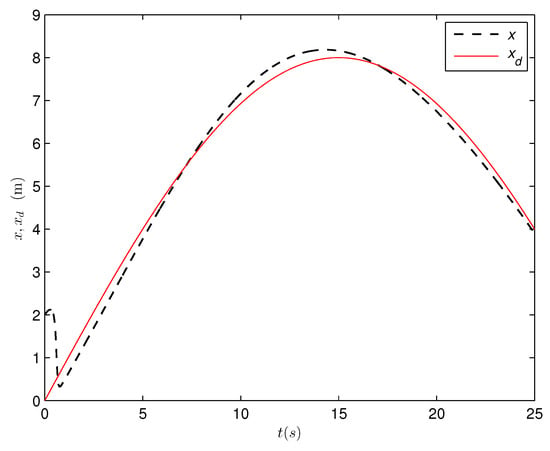
Figure 6.
Surge displacement (traditional adaptive control).
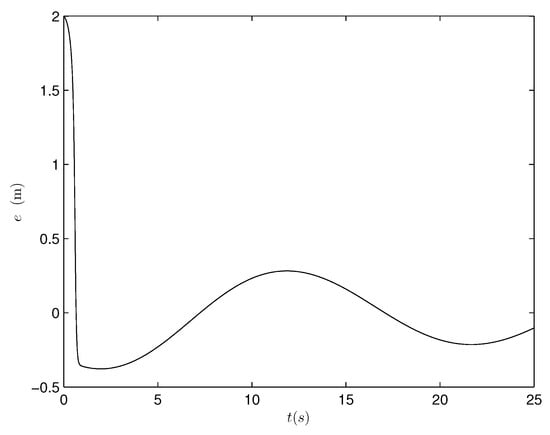
Figure 7.
Surge tracking error (traditional adaptive control).
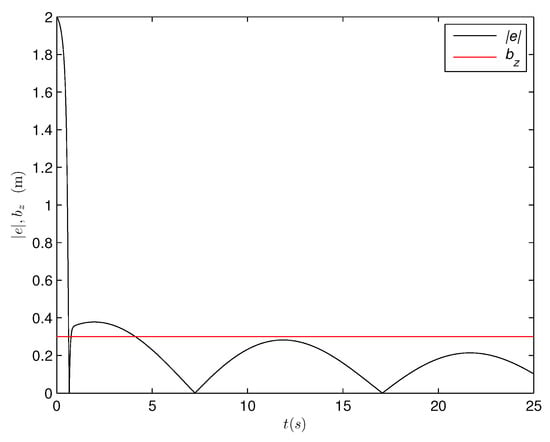
Figure 8.
Absolute value of surge position tracking error (traditional adaptive control).
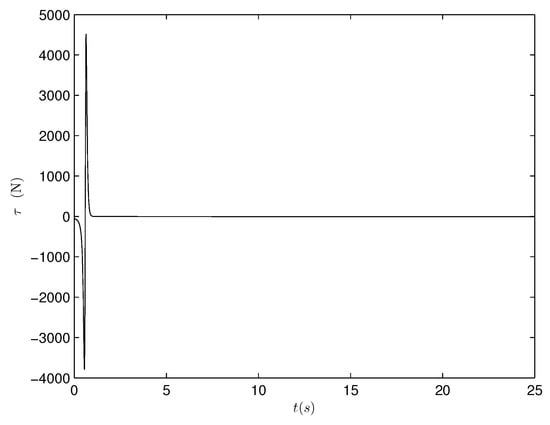
Figure 9.
Control input (traditional adaptive control).
7. Conclusions
The surge position tracking control problem of AUVs is studied in this work. On the basis of constructing an auxiliary trajectory signal and adopting the barrier Lyapunov function, we develop a state-feedback deferred constraint adaptive backstepping control scheme at first. After that, by using coordinate transformation to transform the original system into a chained form system, and by utilizing a linear and nonlinear combined differentiator to accurately estimate the derivative of surge displacement, we develop the output feedback deferred output constraint adaptive controller for AUVs whose velocity signals are not measurable. Finally, the simulation results verify the effectiveness of the proposed adaptive control schemes.
Author Contributions
Investigation, Y.Z.; methodology, O.X.; project administration, Y.Z. All authors have read and agreed to the published version of the manuscript.
Funding
This work was supported in part by Key Research and Development Plan of Zhejiang Province (grant number 2021C03019), in part by Scientific Research Project of the Water Conservancy Department of Zhejiang Province (grant number RB1615) and in par by the Joint Funds of Zhejiang Provincial Natural Science Foundation of China (grant number LZJWZ23E090001).
Institutional Review Board Statement
Not Applicable.
Informed Consent Statement
Not Applicable.
Data Availability Statement
Not Applicable.
Conflicts of Interest
The authors declare no conflict of interest.
References
- Carlucho, I.; De, P.M.; Wang, S.; Petillot, Y.; Acosta, G.G. Adaptive low-level control of autonomous underwater vehicles using deep reinforcement learning. Robot. Auton. Syst. 2018, 107, 71–86. [Google Scholar] [CrossRef]
- Liu, Q.; Huang, R.N.; Chen, Y.; Li, J.P.; Zhao, D.L. Intelligent Sliding Mode Control for Underwater Vehicle. Appl. Electron. Tech. 2017, 43, 117–121. [Google Scholar]
- Wang, X.; Xu, B.; Guo, Y. Fuzzy Logic System-Based Robust Adaptive Control of AUV with Target Tracking. Int. J. Fuzzy Syst. 2022, 1–9. [Google Scholar] [CrossRef]
- Cui, R.; Yang, C.; Li, Y.; Sharma, S. Adaptive neural network control of AUVs with control input nonlinearities using reinforcement learning. IEEE Trans. Syst. Man Cybern. Syst. 2017, 47, 1019–1029. [Google Scholar] [CrossRef]
- Hammad, M.M.; Elshenawy, A.K.; El Singaby, M.I. Trajectory following and stabilization control of fully actuated AUV using inverse kinematics and self-tuning fuzzy PID. PLoS ONE 2017, 12, e0179611. [Google Scholar] [CrossRef]
- Wei, H.; Shen, C.; Shi, Y. Distributed Lyapunov-based model predictive formation tracking control for autonomous underwater vehicles subject to disturbances. IEEE Trans. Syst. Man Cybern. Syst. 2019, 51, 5198–5208. [Google Scholar] [CrossRef]
- Marco, D.B.; Martins, A.; Healey, A.J. Surge motion parameter identification for the NPS Phoenix AUV. In Proceedings of the IARP-1st International Workshop on Autonomous Underwater Vehicles for Shallow Water and Coastal Environment, Lafayette, LA, USA, 17–19 February 1998. [Google Scholar]
- Kumarawadu, S.; Kumara, K.J.C. On the speed control for automated surface vessel operation. In Proceedings of the Third International Conference on Information and Automation for Sustainability, Melbourne, Australia, 4–6 December 2007. [Google Scholar]
- Herlambang, T.; Nurhadi, H. Design of a sliding pid controller for the surge and roll motion control of unusaits auv. Int. J. Comput. Sci. Appl. Math. 2017, 3, 61–64. [Google Scholar] [CrossRef]
- Fossen, T.I. Guidance and Control of Ocean Vehicles. University of Trondheim, 1st ed.; John Wiley & Sons: Chichester, UK, 1999. [Google Scholar]
- Smallwood, D.A.; Whitcomb, L.L. Model-based dynamic positioning of underwater robotic vehicles: Theory and experiment. IEEE J. Ocean. Eng. 2004, 29, 169–186. [Google Scholar] [CrossRef]
- Riedel, J.S. Shallow water station keeping of an autonomous underwater vehicle: The experimental results of a disturbance compensation controller. In Proceedings of the OCEANS 2000 MTS/IEEE Conference and Exhibition, Providence, RI, USA, 11–14 September 2000. [Google Scholar]
- Gao, J.; Xu, D.M.; Li, J.; Weisheng, Y.; Fubin, Z. Adaptive Backstepping Sliding Mode Control for Surge Motion of an Au-tonomous Underwater Vehicle. J. Northwestern Polytech. Univ. 2007, 25, 552–555. [Google Scholar]
- Yu, Y.F.; Yan, Q.Z.; Cai, J.P. Initial correction adaptive back stepping control method for axial motion of underwater vehicles. Fire Control Command Control 2019, 44, 115–119. [Google Scholar]
- Li, X.; Huang, R.N.; Ding, N. Adaptive Backstepping Control of Autonomous Undersea Vehicle with Input Limitation. J. Unmanned Undersea Syst. 2019, 27, 624–628. [Google Scholar]
- Li, S.; Wang, X.; Zhang, L. Finite-time output feedback tracking control for autonomous underwater vehicles. IEEE J. Ocean. Eng. 2014, 40, 727–751. [Google Scholar] [CrossRef]
- Wang, Y.; Chai, T.; Zhang, Y. State observer-based adaptive fuzzy output-feedback control for a class of uncertain nonlinear systems. Inf. Sci. 2010, 180, 5029–5040. [Google Scholar] [CrossRef]
- Chen, W.; Saif, M. Output feedback controller design for a class of MIMO nonlinear systems using high-order sliding-mode differentiators with application to a laboratory 3-D crane. IEEE Trans. Ind. Electron. 2008, 55, 3985–3997. [Google Scholar] [CrossRef]
- Chen, M.; Ge, S.S. Adaptive neural output feedback control of uncertain nonlinear systems with unknown hysteresis using disturbance observer. IEEE Trans. Ind. Electron. 2015, 62, 7706–7716. [Google Scholar] [CrossRef]
- Pisano, A.; Usai, E. Output-feedback control of an underwater vehicle prototype by higher-order sliding modes. Automatica 2004, 40, 1525–1531. [Google Scholar] [CrossRef]
- Refsnes, J.E.; Sorensen, A.J.; Pettersen, K.Y. Model-based output feedback control of slender-body underactuated AUVs: Theory and experiments. IEEE Trans. Control Syst. Technol. 2008, 16, 930–946. [Google Scholar] [CrossRef]
- Liu, S.; Wang, D.; Poh, E. Nonlinear output feedback tracking control for AUVs in shallow wave disturbance condition. Int. J. Control 2008, 81, 1806–1823. [Google Scholar] [CrossRef]
- Zhang, L.; Qi, X.; Pang, Y.; Jiang, D. Adaptive output feedback control for trajectory tracking of AUV in wave disturbance condition. Int. J. Wavelets Multiresolution Inf. Process. 2013, 11, 1350027. [Google Scholar] [CrossRef]
- Zhang, L.J.; Qi, X.; Pang, Y.J. Adaptive output feedback control based on DRFNN for AUV. Ocean Eng. 2009, 36, 716–722. [Google Scholar] [CrossRef]
- Bravo, J.M.; Alamo, T.; Camacho, E.F. Robust MPC of constrained discrete-time nonlinear systems based on approximated reachable sets. Automatica 2006, 42, 1745–1751. [Google Scholar] [CrossRef]
- Bemporad, A. Reference governor for constrained nonlinear systems. IEEE Trans. Autom. Control 1998, 43, 415–419. [Google Scholar] [CrossRef]
- Tee, K.P.; Ge, S.S.; Tay, E.H. Barrier Lyapunov functions for the control of output-constrained nonlinear systems. Automatica 2009, 45, 918–927. [Google Scholar] [CrossRef]
- Jin, X. Iterative learning control for non-repetitive trajectory tracking of robot manipulators with joint position constraints and actuator faults. Int. J. Adapt. Control Signal Process. 2017, 31, 859–875. [Google Scholar] [CrossRef]
- Song, Y.D.; Zhou, S. Tracking control of uncertain nonlinear systems with deferred asymmetric time-varying full state constraints. Automatica 2018, 98, 314–322. [Google Scholar] [CrossRef]
- Liu, L.; Gao, T.; Liu, Y.J.; Tong, S.; Chen, C.P.; Ma, L. Time-varying IBLFs-based adaptive control of uncertain nonlinear systems with full state constraints. Automatica 2021, 129, 109595. [Google Scholar] [CrossRef]
- Hou, Y.; Wang, H.; Wei, Y.; Iu, H.H.C.; Fernando, T. Robust adaptive finite-time tracking control for Intervention-AUV with input saturation and output constraints using high-order control barrier function. Ocean Eng. 2023, 268, 113219. [Google Scholar] [CrossRef]
- Wang, C.; Lin, Y. Decentralized adaptive tracking control for a class of interconnected nonlinear time-varying systems. Automatica 2015, 54, 16–24. [Google Scholar] [CrossRef]
- Wang, X.; Liu, J. Differentiator Design and Application—Signal Filtering and Differentiation, 1st ed.; Publishing House of Electronics Industry: Beijing, China, 2010. [Google Scholar]
- Chen, Q.; Ren, X.; Na, J.; Zheng, D. Adaptive robust finite-time neural control of uncertain PMSM servo system with nonlinear dead zone. Neural Comput. Appl. 2017, 28, 3725–3736. [Google Scholar] [CrossRef]
- Prestero, T. Verification of a Six-Degree of Freedom Simulation Model for the REMUS Autonomous Underwater Vehicle. In Proceedings of the Unmanned Untethered Submersible Technology 2001, Durham, NH, USA, August 2001. [Google Scholar]
Disclaimer/Publisher’s Note: The statements, opinions and data contained in all publications are solely those of the individual author(s) and contributor(s) and not of MDPI and/or the editor(s). MDPI and/or the editor(s) disclaim responsibility for any injury to people or property resulting from any ideas, methods, instructions or products referred to in the content. |
© 2023 by the authors. Licensee MDPI, Basel, Switzerland. This article is an open access article distributed under the terms and conditions of the Creative Commons Attribution (CC BY) license (https://creativecommons.org/licenses/by/4.0/).